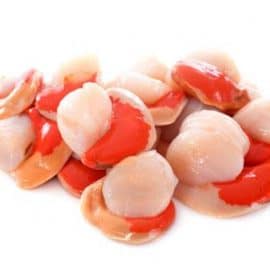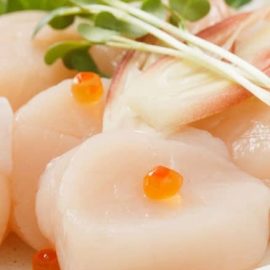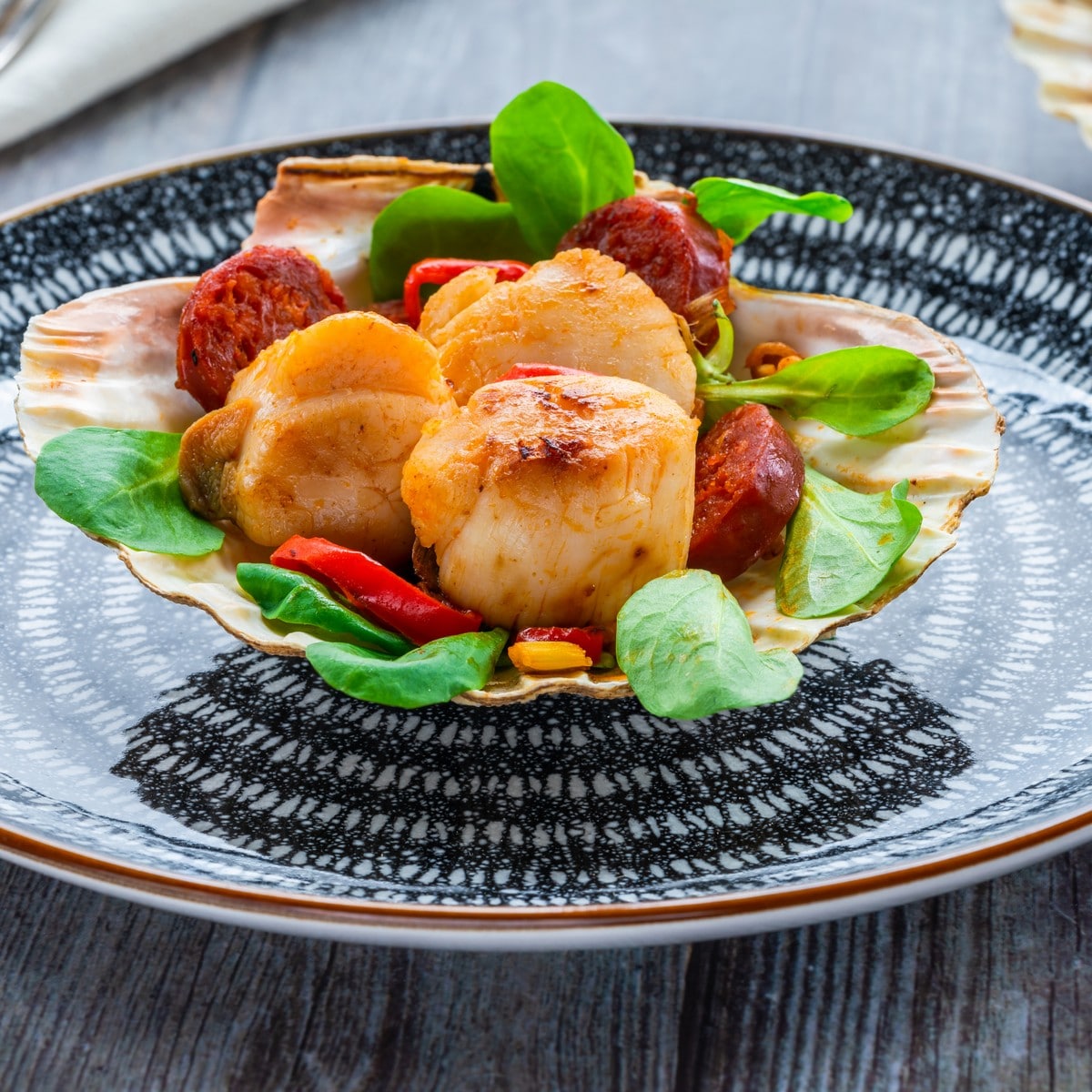
Introduction
Scallops are bivalve molluscs of the family Pectinidae. They are one of the world’s most widely distributed and commercially valuable shellfish species, with an estimated global population in the billions.
They have been popularly consumed by people for centuries and have become a staple ingredient in many dishes.
Scallops are like a hidden ocean gem as they have exciting anatomy, ecology, and physiology that make them fascinating creatures.
Description & Characteristics
Scallops are bivalve molluscs that inhabit both shallow and deep waters of the world’s oceans, seas and rivers. They have a two-part shell that is convex or almost flat on top and concave or curved on the bottom. The upper part of their shells can be divided into two equal parts, which are held together by a hinge and several adductor muscles. When these muscles open, their shells separate, allowing them to move freely through the water.
The average scallop has an eye at the end of each half of its shell, which allows it to sense light, movement and pressure changes in its environment. Scallops also have a siphon near the hinge to filter food out of the water. The inside surface of each half shell is lined with small sharp spines called “scales”, which are used for defence against predators.
Scallops vary in size depending on species, but most measure between 3 cm (1 inch) and 15 cm (6 inches) across when fully opened. Their shells can be smooth or patterned with ribbed ridges and range in colour from white to various shades of yellow, orange, brown, blue or purple. Scallops also have large bright eyes that can range from yellow to pinkish-red in colour.
In addition to being edible, scallops are also popular aquarium pets due to their attractive shells, unique behaviour and bright eyes. Some species of scallops, such as Pecten jacobaeus are even used for biomedical research due to their ability to regenerate lost body parts like arms or gills quickly after injury or damage.
Biology
The biology of scallops is a fascinating field of study, with its intricate anatomy and numerous adaptations to its environment. These succulent molluscs have evolved unique structures that enable them to survive in their aquatic habitat. With the help of their thick shells and muscular foot, scallops can feed, reproduce, protect themselves from predators, and move around in search of food or shelter.
Scallops have a unique adaptation that allows them to move around using their muscular foot called a “pedal disc”, which contains hundreds of tiny cilia (hairs) that vibrate when stimulated by water pressure. As a result, they are able to escape predators or propel themselves towards food sources quickly.
Scallops also possess eyes along the edge of their mantel (the tissue between the shells), which are used for perceiving light intensity and discerning shapes nearby. Additionally, these creatures possess special glands known as “labial palps”, which line the inside of their shells; this organ is used for feeding by filtering plankton out of the water column.
Scallop biology is characterised by a combination of physical characteristics that allow it to thrive in almost any marine environment on Earth; it can be found both in shallow waters near sandy beaches and deep ocean depths where it can find plenty of food sources such as phytoplankton and tiny crustaceans to eat. These versatile creatures have remained relatively unchanged since they first appeared on Earth millions of years ago.
Habitat And Distribution
Scallops are widely distributed in all the world’s major oceans. They inhabit depths ranging from shallow waters near the seashore to great depths on continental shelves and slopes. Alluding to their global reach, scallops remind us of how interconnected our oceans are and that they cover 70% of the planet’s surface.
When looking at distribution and habitat, it is essential to consider the different species of scallops. Other species inhabit different areas due to their various adaptations. Warm water species such as Pecten jacobaeus are commonly found in tropical or subtropical waters, while cold water species such as Placopecten magellanicus live mainly in temperate and subarctic regions.
Scallops can also be benthic (living on or on the seafloor) or pelagic (swimming freely). Benthic species typically attach themselves to soft substrates like mud or sand, while pelagic scallops swim freely through open water with the help of their muscular foot and wings.
The habitat for most scallops consists of the following:
- Soft substrates: Including mud, sand, gravel, clay, rubble and other debris.
- Temperature range: Depending on species, between 4-30°C (39-86°F).
- Salinity levels: Depending on species, between 20-40 ppt (parts per thousand).
- Light levels: In shallow waters, light levels are higher than in deeper waters, depending on the species.
- Oxygen content: Commonly 2-6 ml/L (milliliters per litre).
These variations depend primarily on the type of scallop being considered and its adaptation to its environment. In addition to this variety in habitats, there is also variation within individual populations in terms of size, age structure and reproductive cycle determined by environmental factors such as temperature and salinity.
Life Cycle of Scallops
The life cycle of scallops is relatively short, with a lifespan of only one year. Spawning occurs in late spring and early summer, and the eggs are fertilised externally. After fertilisation, the larval stage begins, with the larvae drifting in ocean currents before settling on the seabed at around 75 days old.
Scallops can reach maturity within six months, though some species may take longer. When mature, adult scallops are typically between 3-10 cm (1-4 inches) in size and have a long lifecycle of spawning and growth before reaching sexual maturity. The post-spawning period is characterised by slow growth until the next spawning season begins.
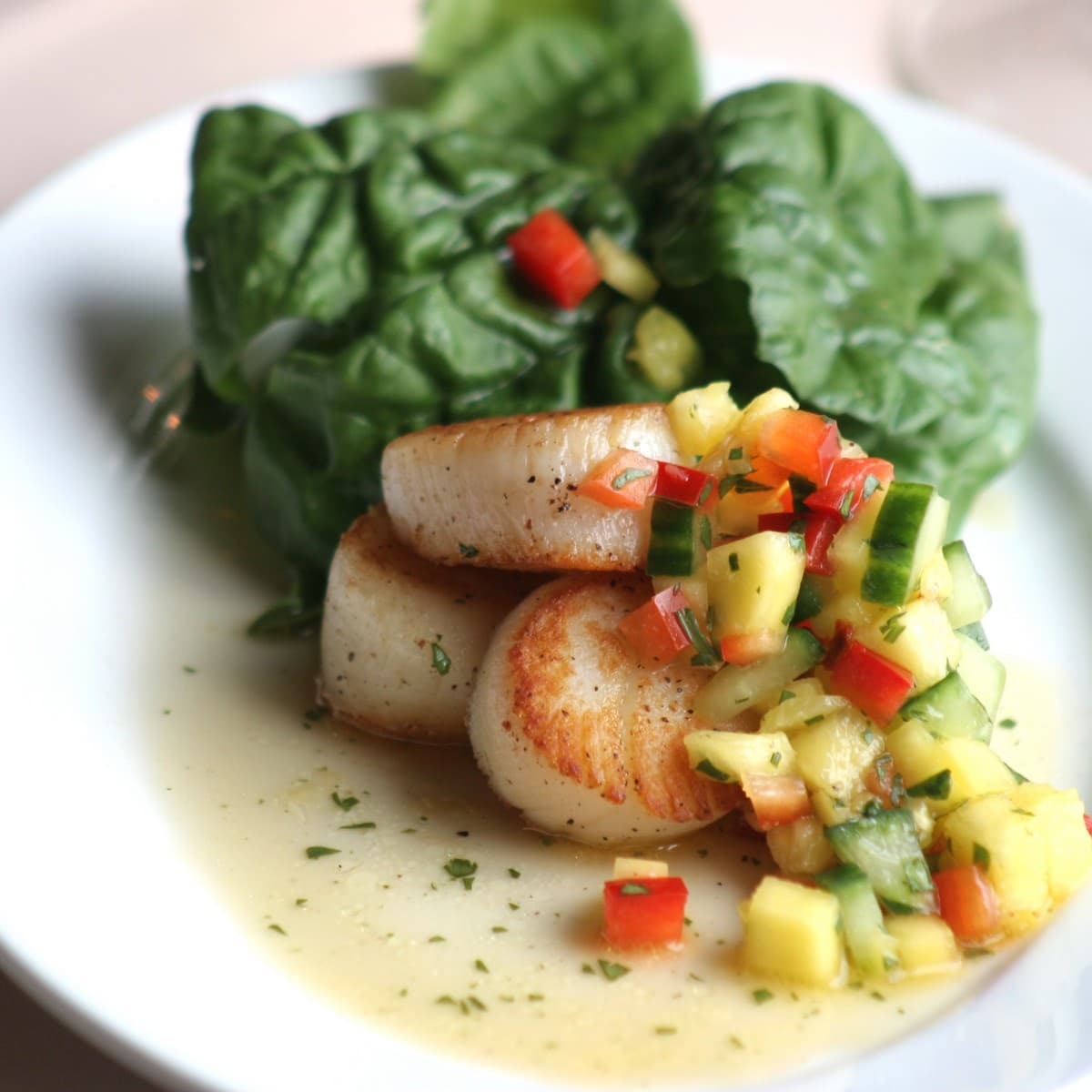
Scallop populations are highly vulnerable to overfishing due to their short life cycles; they reproduce quickly and can be easily depleted if not managed carefully. As well as overfishing, habitat destruction due to coastal development can also impact scallop populations.
Scallops’ Diet
Scallops, a type of mollusc, are known for their distinctively sweet flavour and texture. They are found in many habitats throughout the world’s oceans. But what do scallops eat? What kind of diet do they have?
Rhetorically, how does such a tiny organism survive in various environments with many predators around? Generally speaking, scallops feed on phytoplankton and zooplankton. They use their modified foot, called a “byssal muscle”, to filter water through their gills and capture the tiny organisms that pass through. Depending on the environment and type of scallop, they may also consume detritus, diatoms, bacteria, protozoans, and other microorganisms.
Scallops close their shells tightly when predators such as crabs or starfish threaten them. This helps protect them from being eaten; however, it also prevents them from feeding while closed like this.
Species And Taxonomy
They are members of the mollusc family, possessing two-hinged shells with dozens of radiating ribs and a soft body inside. There is an extensive variety of scallops worldwide, each with its taxonomic classification.
Scallops belong to the species Pectinidae and inhabit tropical, temperate and deep waters worldwide. The three main genus within Pectinidae is Chlamys, Placopecten and Argopecten. Each family contains several genera with unique characteristics such as shell shape, colouration and size. Numerous species can be further divided into subspecies within these genera based on geographical regions or other physical traits.
Understanding scallop taxonomy is critical to understanding their biology, ecology, populations and habitats. With this knowledge, scientists can better manage scallop fisheries to ensure healthy oceans now and in the future.
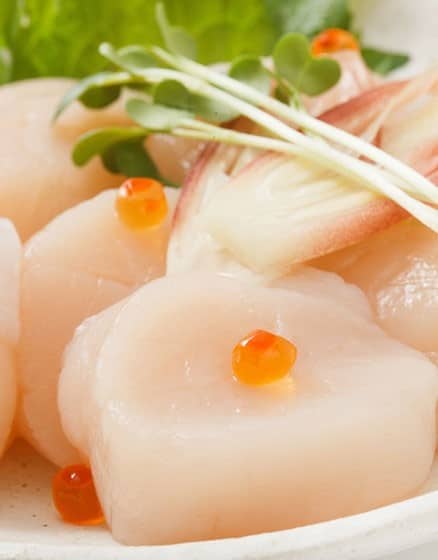
Etymology
The term ‘scallop’ etymology is derived from the Latin scallopinus, a diminutive of a scallop. This term was first used to describe the edible bivalve molluscs in the early 16th century. The origin of this term can be traced back to French and Old Italian dialects which refer to the shellfish as coquille Saint-Jacques, or “St. James’s Shell”. In Middle English, this term was further shortened to scalle, which eventually became a scallop.
The word scallop has been used since ancient times to refer to objects resembling shells. This includes circular objects such as coins, dishes, and buildings with semicircular arches or windows. These objects are sometimes referred to as “scalloped” due to their resemblance to the shell shape of a scallop. In art and architecture, the pattern made by multiple concave curves is known as “scalloping”.
Scallops have also been used in various religious contexts throughout history, including depictions in Christian iconography and traditional Japanese sculpture and painting.
Fisheries
Scallops have long been a significant source of food for many fisheries around the world. In recent years, their popularity has skyrocketed as they become a more sustainable seafood choice. While scallops are harvested in wild and farmed settings, they are most commonly found on menus and store shelves harvested from natural environments. Many fisheries take advantage of the abundance of scallops while carefully managing their populations to ensure future availability.
The two main methods used to harvest scallops are dredging and diving. Dredging is when the scallop beds are disturbed by a heavy metal bucket or rake dragged along the seafloor, which collects the scallops and brings them to the surface. Diving is when fishers manually pick up individual scallops from their beds with hand tools such as tongs or suction cups. Both methods can damage habitats if not done correctly, so anglers must follow best practices for sustainable harvesting to maintain healthy populations.
Scallop fisheries have adopted various measures to protect their stocks from overfishing and preserve wild habitats. Using biodegradable fishing gear is becoming increasingly popular as it minimises damage to benthic habitats while ensuring a safe harvest. Additionally, anglers often use size limits or quotas on total catch amounts to maintain an adequate population size for future generations. Governments also play an integral part in regulating scallop fisheries by setting regulations on vessel operation, seasonal closures, and other management measures to protect these resources for future use.
Sustainability
The sustainability of scallops has become increasingly important in recent years, as the species has been overexploited and harvested beyond reasonable limits. As a result, numerous initiatives have been established to ensure that scallop fisheries are managed sustainably to protect their populations from depletion. Like a ship navigating choppy waters, sustainable practices must be implemented to keep the industry afloat.
One such initiative is the United Nations Food and Agriculture Organization’s (FAO) Code of Conduct for Responsible Fisheries. This code provides guidelines for managing global fish stocks and sets standards for sustainable harvesting practices that can help ensure the long-term health of these resources. Additionally, some countries or regions have adopted regulations regarding how many scallops can be harvested from a specific area and how often those areas can be fished. These regulations can vary widely depending on the population size and status of the species in question.
Furthermore, individual fishing operations can take steps towards more sustainable harvesting practices by using traps or dredges instead of trawls when possible. This reduces the amount of bycatch – animals unintentionally caught during fishing – which helps protect other species while preventing overharvesting particular target species like scallops. By implementing these measures, fisheries can help ensure that they do not deplete local populations while providing food and economic opportunities to local communities.
Scallops As Food
Scallops are popular seafood among many cultures and have been eaten for centuries. Scallops are popular worldwide for their sweet taste and succulent texture.
As food, they are savoured in many delicious dishes that range from simple preparations to complex recipes. Their delicate taste and smooth texture make them an ideal choice for many seafood lovers.
Scallops have a mild, slightly sweet flavour enhanced by their succulent texture when cooked properly. They can be served raw, steamed, fried, grilled or baked.
Many cooks like to pair scallops with light sauces that complement their flavour without overpowering it. Scallops also work well in soups and stews since their flavours blend easily with other ingredients. In addition to being used as an ingredient in dishes, scallops may also be served as a main course dish with accompaniments such as vegetables or potatoes.
Scallops are known for being healthy and nutritious as they are low in calories and fat while high in protein and vitamins B12 and omega-3 fatty acids.
When choosing scallops at the store or market, look for those with firm flesh that has a creamy white colour; avoid discoloured or slimy specimens. Properly stored scallops can last up to two days when refrigerated; if frozen, they may keep up to three months when stored correctly.
How To Prepare Scallops
The preparation of sea scallops is an art form in itself. Before cooking, the scallop must be cleaned and any excess muscle removed. Cut the abductor’s power away from the scallop’s main body before opening the shell with a knife. The roe can then be separated from the protein-rich adductor muscle.
After cleaning, it is essential to rinse off any remaining dirt or debris. The fresh scallops can then be cooked by baking, steaming, frying, or grilling.
When cooking scallops, it is best to use a light oil such as olive oil or butter to add flavour and prevent sticking during the cooking process. It is also important to cook them sparingly as they will become tough and rubbery if cooked too long. Depending on the size of the scallop, cooking times can range from 1-5 minutes per side over medium heat olive oil, until the bay scallop turned golden brown and slightly crispy on the outside.
Best Side Dishes Paired With Scallops
There are many options for pairing scallops with side dishes. Scallops’ delicate and sweet flavour pairs perfectly with various ingredients and flavours, making it easy to create an unforgettable meal. Here are a few popular sides that pair well with scallops:
First, vegetables such as asparagus, spinach, peas and baby carrots can be cooked alongside the scallops for added crunch and nutrition. These vegetables can be roasted or boiled, depending on your preference. Secondly, mashed potatoes or crispy potato wedges can pair nicely with scallops. Potatoes provide a creamy texture that perfectly complements the delicate flavour of the seafood. Finally, rice is another excellent option to serve along with scallops. Whether you choose white rice or brown rice, this starchy side will help balance the meal by providing a different flavour profile.
No matter what side dishes you choose to serve with your scallops, it is vital to remember that each ingredient should stand out without overpowering the other components. When preparing these sides, consider adding herbs like parsley or basil for more depth of flavour and butter for richness and creaminess. Experimenting with various flavours will ensure your guests enjoy a delicious meal every time!
Popular Scallop Recipes
As the saying goes, “Variety is the spice of life.” This certainly applies to the culinary world, where different recipes and ingredients can open up new possibilities for taste buds. One popular ingredient that has become increasingly popular over the past few decades is scallops.
Scallops are shellfish in salt and fresh water, prized for their flavour and texture. They are often used in various dishes, from soups to pasta dishes.
When it comes to large sea scallops, there are many popular recipes out there. For starters, they make a great addition to salads, garlic bread, or pasta dishes like zucchini noodles when lightly browned with butter or oil. Another popular method is to cook scallops by searing them on high heat and then serving them with a sauce such as lemon juice caper sauce or garlic butter sauce. They can also be enjoyed raw as sashimi or carpaccio dishes.
Additionally, bay scallops can be baked on parchment paper with vegetables like carrots and onions and parmesan cheese for an easy weeknight dinner with plenty of flavours. Finally, scallops can also be added to chowders or bisques for a rich, salty flavour. No matter what preparation method you choose, scallops offer plenty of possibilities for creating absolutely delicious meals that will please any palate.
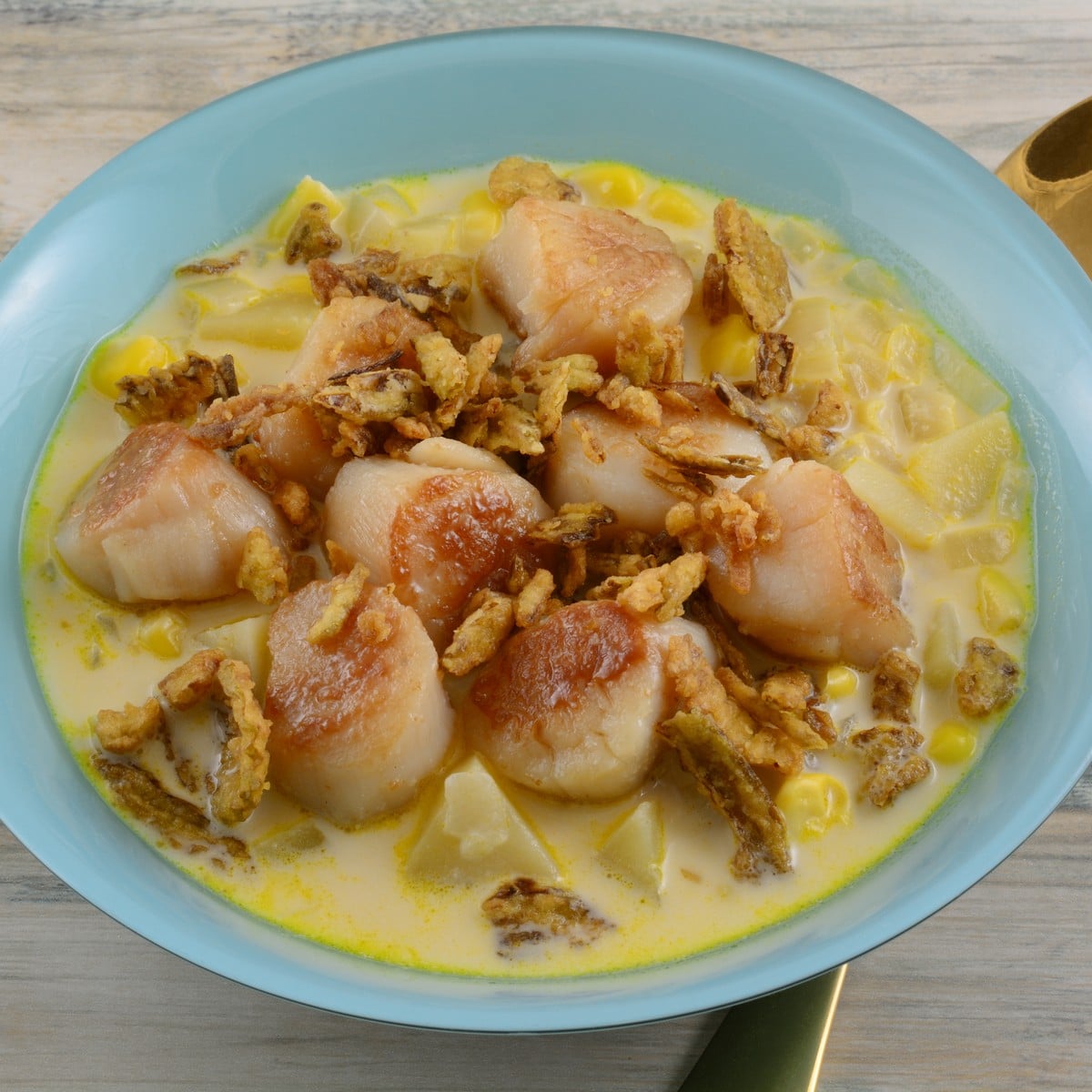
Comparison To Other Seafood
Often served in restaurants, scallops can be prepared in various ways, such as grilled, fried, or poached, and are enjoyed by seafood lovers worldwide. While scallops have been a favourite among many cultures for centuries, how do they compare to other types of fish?
Regarding nutritional value, scallops usually contain higher levels of vitamins and minerals than most other types of fish. They are also high in protein and healthy fats like omega-3s, which may help reduce inflammation and heart disease risk. Additionally, scallops contain fewer calories per serving than other types of seafood.
Regarding flavour profiles, scallops tend to have a mild yet distinctive taste similar to lobster or crab meat. The texture is often described as buttery with a hint of saltiness.
Compared to other types of fish, scallops provide a unique flavour that many people enjoy. However, some fish may have more complex flavours depending on their preparation method or the sauces used during cooking.
Regarding sustainability concerns, most wild-caught scallop fisheries are considered sustainable compared to other fisheries due to their relatively low rates of bycatch and harm caused by fishing gear such as trawling nets. F
Furthermore, because scallop populations proliferate under proper management practices and harvesting regulations, they can be an excellent source of sustainable seafood for consumers who wish to make responsible choices about what they eat.
History of Scallops
The history of scallops is ancient, with references to shellfish being found in the writings of Ancient Greece and Rome. The name ‘scallop’ is derived from the Medieval Latin word ‘scalpellus’, which means “small knife” or “scythe”, referring to the shape of its shell. Scallops have been an invaluable food source for centuries, with references to them in literature, art, and even religion. In Ancient Greece, scallops were a symbol of fertility and abundance, while in Christianity, they are associated with St. James due to his pilgrimage to Santiago de Compostela.
Scallops have been used as a food source by many cultures throughout history. In the Middle Ages, they were popular among European fishermen who harvested them from shallow waters off the coast of Britain and Ireland. They were also prized by Native American tribes living along the Atlantic Coast, who ate them raw or cooked them over fires. During the Renaissance, scallops symbolise wealth due to their rarity and high price point.
As well as having culinary uses, scallop shells have long been used for decorative purposes such as jewellery and home décor items. With their rich history and numerous benefits, it’s easy to see why scallops remain so popular even today!
Conclusion
Scallops are a popular seafood choice, renowned for their unique flavour and texture. When cooked correctly, they can be incredibly delicious and savoury.
If you want to enjoy the fantastic flavour of these succulent treats without fail, then take your time consuming them – it’s truly an unforgettable culinary experience that cannot compare!
